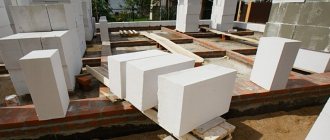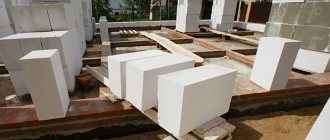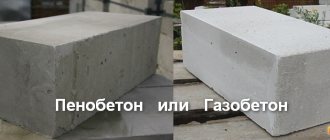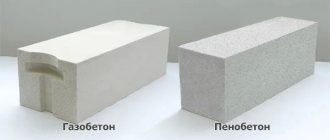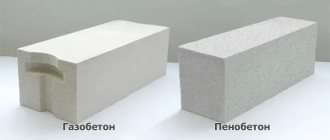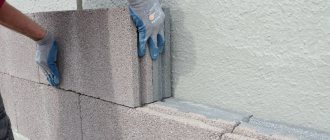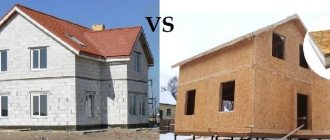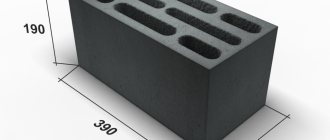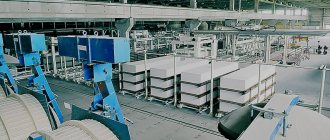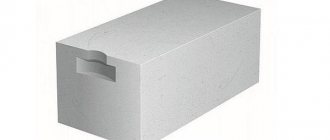Let's figure out what the features of materials such as aerated concrete and gas silicate are, what the difference is between them, and which one is more suitable for building a house. Aerated concrete and gas silicate blocks are similar in appearance, so making a choice between them is not so easy.
There are differences in the compositions, manufacturing technologies and some properties of these materials. Read to the end and compare their technical characteristics to understand the advantages and subtleties of using aerated concrete and gas silicate.
House made of aerated concrete blocks Source country-housebuilding.rf
What is aerated concrete and gas silicate
These building materials are varieties of cellular concrete, which is characterized by a porous structure and low density. Durable and lightweight aerated concrete blocks have increased thermal insulation properties. The low thermal conductivity of cellular concrete is due to the presence of numerous voids filled with air.
Many people have a question about the difference between aerated concrete and gas silicate, what is the difference between them.
Both materials contain cement, sand, lime, gas-forming agents (aluminum paste or powder) and water. The difference is in the ratio of components and block manufacturing technologies.
Aerated concrete is a mixture whose main component is Portland cement. When the concrete mass, to which a gas-forming agent is added, hardens, spherical voids with a diameter of 1-3 mm are formed in it. The reason for their appearance is the release of hydrogen during a chemical reaction between aluminum and lime.
The composition of aerated concrete includes:
- Portland cement – 50-70%;
- Sand – 20-40%;
- Lime – 1-5%;
- Gas-forming agent – 0.04-0.09%;
- Water – 0.25-0.8%.
Construction of a house from aerated concrete blocks Source stroitelstvo-remont-sochi.ru
Gas silicate has a lime-silica binder base, consisting of silicate sand (up to 60%) and lime (24%). Aluminum powder or paste is also added to form cells.
Due to the difference in the content of cement and lime, products made from these materials differ in color. Aerated concrete blocks have a gray tint, while gas silicate blocks are white.
Construction of a wall from gas silicate Source blockexpert.ru
Manufacturing method
The main raw material used for the production of porous concrete is cement.
In the production of gas silicate it is replaced by lime. At the initial stage, the main component is mixed with water and sand cleared of impurities. A gas-forming substance (aluminum powder) is added to the finished composition. The finished mixture is poured into molds.
Expert opinion Vitaly Kudryashov builder, aspiring author
Ask a Question
The subsequent stage of processing aerated concrete occurs according to different principles, resulting in 2 building materials with different technical characteristics.
The mold with the mixture is placed in an autoclave oven, where it is dried under high pressure. During hardening, gases are released, then many cells are formed in the structure of the block through which vapors escape. This technique increases strength and density. The resulting material is actively used in construction as the main material in the construction of load-bearing walls.
The second method of making aerated concrete is to dry it naturally. The resulting cellular block is used in the field of construction and finishing works, in particular, for insulating building facades.
Expert opinion Vitaly Kudryashov builder, aspiring author
Ask a Question
Healthy! In fact, there are concepts on the market: aerated concrete/gas silicate, autoclaved, non-autoclaved. Confusion in terms is most often caused by incompetent sellers who do not attach importance to the names of different materials.
Technologies for manufacturing blocks from aerated concrete and gas silicate
To understand the difference between aerated concrete and gas silicate, it is necessary to take into account the difference in the methods of manufacturing such materials.
To obtain cellular concrete, 2 technologies are used: autoclave and non-autoclave.
In the non-autoclave production of porous blocks, solidification of the mass after adding a gas-forming agent occurs under natural conditions, without additional processing. It takes 28 days for the concrete to completely harden.
Autoclave technology allows you to speed up this process up to 12-15 hours by maintaining the concrete mass under a pressure of 8-14 atm at temperatures up to 175-190˚C.
The advantages of autoclave technology are:
- Possibility of giving gas blocks an exact geometric shape and standard dimensions;
- More uniform distribution of voids, enhancing heat and sound insulation;
- Increasing the hardness of blocks, reducing the likelihood of shrinkage and cracking of the material.
Warning! A significant disadvantage is the increased fragility of blocks processed in an autoclave. Special care is required when transporting and stacking them. To secure heavy objects on walls made of autoclaved aerated concrete, only anchor bolts with special spacers are suitable.
Reliable fastenings for aerated concrete walls Source eyecorrector.ru
The advantages of non-autoclave blocks are lower hygroscopicity and lower price.
Aerated concrete is made using both methods.
For the production of gas silicate, only autoclave technology is used.
See also: Catalog of companies that specialize in the construction of aerated concrete houses
Features of working with gas blocks
Cellular concrete is rarely used for laying foundations , since it is necessary to construct additional insulation from moisture. For the same reason, they are not used for the construction of a basement.
Stones are chosen so that they do not have any curvature or geometry violations. Due to unevenness, the amount of solution increases.
Use horizontal or vertical reinforcement with metal rods.
Vertical is used in certain conditions :
- the building is located in an earthquake-prone region;
- on a steep mountain slope;
- Frequent hurricanes are recorded in the area;
- if the walls have large windows.
For masonry, use cement-sand mortar or adhesive mixture , which is sold dry. It is diluted with water according to the instructions, then mixed with a drill and a whisk until smooth. In winter, frost-resistant glue is used , or modifiers are added to the solution to normalize the setting. The masonry is carried out with ligation of vertical and horizontal seams.
General advantages and disadvantages of aerated concrete and gas silicate
Aerated concrete or gas silicate have the same structure, due to which they have the following common advantages:
- Low thermal conductivity coefficient - from 0.09 W/m˟С (For comparison, it can be noted that for brick this figure is 0.5-0.8 W/m˟С).
- Good frost resistance (50 or more defrosting cycles).
- Lightness, strength, environmental friendliness, fire safety.
- Ease of processing blocks (cutting, grinding). A saw is used to cut aerated concrete and gas silicate.
Cutting aerated concrete blocks using a saw Source mtdata.ru
- Rapid formation of masonry.
Common disadvantages of aerated concrete and gas silicate are:
- The ability of porous blocks to absorb moisture well, the need to use special coatings to protect walls from dampness.
- Increased risk of damage to aerated blocks during transportation, storage and laying of walls.
- Possibility of shrinkage of materials by 1-3 mm as they dry. This process leads to a decrease in the strength of the masonry, the formation of cracks in the walls and the destruction of the plaster.
- Poor adhesion of concrete to binding materials used in creating masonry and finishing walls made of aerated blocks. There is a need to use adhesives with increased adhesion.
Damaged gas silicate blocks Source ytimg.com
What to look for when purchasing
Let's list the main points.
- Geometry. Extremely important for future construction. The laying is carried out on a thin layer of glue, the thickness of which may not be enough to smooth out irregularities. You will have to either increase the thickness of the adhesive composition, which is not good, or trim off the protruding parts, which will significantly complicate and lengthen the construction process. Well, indirectly, even blocks are a sign of solid production.
- Density of the material. The denser the blocks, the stronger they are. And more expensive, by the way. However, do not forget that an increase in strength entails a decrease in thermal insulation qualities. Therefore, with cellular building materials, as a rule, it is better to play it safe and choose the most durable one, which does not work very well. We need a middle ground: strong enough and good thermal insulation.
- Size and type. It is especially important if you plan to lay the masonry yourself, to choose a size that is comfortable for you. And it will be decided whether these will be ordinary blocks or tongue-and-groove ones.
- Manufacturer. Big companies don't cut corners. For little-known brands, stricter checks and controls are required.
Comparison of the properties of aerated concrete and gas silicate
When figuring out how aerated concrete differs from aerated silicate and what is better to use in the construction of various objects, it is necessary to compare the technical characteristics of these materials.
| Specifications | Aerated concrete | Gas silicate |
| Density, kg/cubic. m | 300-1200 | 300-1200 |
| Thermal conductivity, W/m˟S | 0,09-0,35 | 0,11-0,16 |
| Frost resistance (number of freeze-thaw cycles) | 25-75 | 25-150 |
| Shrinkage, mm/sq. m | 0,5 | 0,3 |
| Moisture absorption (% by weight of material) | 16-25 | 25-30 |
| Compressive strength, MPa | 1,5-2,5 | 1-5 |
| Compressive strength, MPa | 40 | 30 |
| Compressive strength, MPa | 190-250 | 190-250 |
Production technology
Foam concrete and aerated concrete are produced using different technologies. Let's take a closer look at them.
Aerated concrete blocks are produced as follows:
- First, the necessary materials are prepared in the required proportions (these include sand, lime and cement). Being in a dry state, they are mixed using special equipment for 4-5 minutes. After this, a suspension of aluminum powder, based on water, is added to the mixed composition.
- As mixing progresses, the lime reacts with the aluminum. Due to this, hydrogen is formed. Due to strong gas formation, air bubbles form in the composition. They are evenly distributed throughout the solution.
- After this, the finished composition is poured into the mold. It must be preheated to 40 degrees. Filling is done to ¼ of the container volume.
- When the composition is sent to the molds, they are transferred to a special chamber, where further pore formation of the material takes place. As a result, the volume of the resulting mass begins to gradually grow and acquires the properties of strength. To activate the necessary reactions in the solution, as well as for its optimal distribution in the form, they turn to vibration.
- When the resulting composition reaches pre-hardening, any irregularities must be removed from its surface. This is done using wire strings.
- Next, the composition is taken out of the chamber and transferred to the cutting line.
- The next step in the production of gas blocks is to send them to the autoclave.
Often, aerated concrete slabs are marked with the designation AGB (implying autoclave material). At the same time, the autoclave itself is a kind of “pressure cooker” of impressive dimensions. Under its conditions, a pressure of 12 atm is injected and then maintained. As for the temperature, it should be 85-190 degrees. In this environment, aerated concrete slabs are prepared within 12 hours.
When the blocks are completely cooked in the autoclave, they are further divided, since during preparation in some places they can connect with each other. After this, these materials are placed in a special heat-shrinkable material or polyethylene.
Aerated concrete is also produced without the use of an autoclave. In this case, the composition hardens under natural conditions - in this case, there is no need to use special equipment.
Foam concrete is made a little simpler and lighter. There are 2 methods of its production - cassette and sawing.
The cassette method involves pouring the solution into special molds.
The technology, called sawing, involves pouring the solution into one large container, after which it is allowed to harden and further cut into individual elements of the required dimensions.
To make foam concrete blocks, cement of the M400 and M500 grades, clean sand without clay, a foaming agent, potassium chloride and, of course, water are used.
Features of the use of aerated concrete and gas silicate blocks
When figuring out which is better - gas silicate or aerated concrete, and what is the difference between these substances, it is important to understand the features of their use. In this case, it is necessary to take into account not so much the difference in composition as the correct use of materials.
- For laying blocks of aerated concrete and gas silicate, a special adhesive mixture is used, which, in addition to cement and sand, contains additives that improve adhesion and accelerate the setting of the binder mortar;
- Considering the increased hygroscopicity of cellular concrete, façade walls made of aerated concrete must be plastered, covered with a layer of moisture-proofing putty, or other means used to protect external walls from precipitation. To make them less wet by rain, it is necessary to install an overhanging roof;
Original decoration of aerated concrete walls with bricks and porcelain tiles Source expertfasada.ru
- For insulation, painting or finishing of facades, it is necessary to use materials with good vapor permeability. At the same time, moisture will not be retained in the concrete blocks and the walls will not mold;
Array structure
Gas silicate and aerated concrete have another distinctive feature - hygroscopicity. The increased hygroscopicity of gas silicate contributes to the saturation of the concrete mass with moisture, which promotes the gradual destruction of concrete under the influence of temperature changes. Aerated concrete has increased resistance to moisture absorption and has a more durable structure of the concrete mass. It is easy to conduct an experiment by immersing each of these materials in water.
Despite the varying degrees of hygroscopicity, the blocks require protection of the cellular surface with plaster. Premises built from cellular concrete provide a comfortable temperature regime and a microclimate favorable for living.
Video description
About whether it is possible to do without insulating walls made of aerated concrete - in the following video:
- Under aerated concrete and gas silicate blocks, waterproofing material must be laid on the foundation;
- To prevent shrinkage and destruction of the walls, during the laying of the blocks, reinforcement is made in the first and every fourth row, as well as in the area of window openings.
Reinforcement of a load-bearing wall during the construction of a house made of aerated concrete Source zaggo.ru
External difference
An unprepared person, seeing similar building materials nearby for the first time, will not be able to give an exact answer as to where the gas silicate block is and where the aerated concrete block is. But they have their own visual differences, which are determined by their composition and production technology. For example, Portland cement is not used in the manufacturing process of silicate products. But in the creation of aerated concrete it is needed, since it is its binding element. This factor affects the color of the products, which is the external difference between gas silicate blocks and aerated concrete:
- So, the first ones are created using the autoclave method and contain a large amount of lime, due to which they have a white color;
- In the second products, the acquisition of characteristics occurs under conditions of natural hardening using Portland cement, which gives them a gray tint.
Due to changes in the amount of binder in materials, their color deviates from other similar products. Thus, with an increase/decrease in the cement content in aerated concrete, its color can vary, ranging from dark gray to light gray. But for silicate options, the color scheme starts with bright white and ends with a grayish-white color. In addition, the difference between similar building materials lies in the different level of hygroscopicity:
- Gas silicate at high humidity absorbs it faster, because when a sharp temperature change occurs, this leads to a violation of the integrity of the blocks;
- It is more difficult for liquids to get into aerated concrete products, which is due to the closed air pores. Thanks to this, such materials have good strength and moisture resistance.
Such blocks require finishing due to their porous outer surface. To create comfortable conditions in the premises with their help, it is necessary to carry out proper external and internal decoration.
Comparing characteristics
- The main difference between gas silicate and gas block is its higher thermal insulation and strength qualities due to the uniform placement of hollow cells throughout the volume of the finished product.
- But in terms of indicators such as strength and fire resistance, it is aerated concrete that is ahead. And although increased strength leads to increased weight, which creates additional loads on the foundation, it allows the material to be used for the construction of structures with increased explosion and fire and seismic hazard.
- In terms of frost resistance, aerated concrete is also significantly superior to its rival due to lower water absorption.
- Factory production guarantees strictly consistent geometry of gas silicate products, which allows reducing the consumption of materials required for their laying (glue) and finishing (plaster).
- A building made of gas silicate has a more beautiful and aesthetic appearance even without additional finishing.
- What else distinguishes gas silicate from aerated concrete is its higher price. Which is explained by the complex process of its manufacture.
In all other indicators, such as strength, durability, laying speed, the materials are almost the same.
Which material is warmer?
Which composition retains room heat better? Gas silicate has reduced frost resistance. It is inferior to foam concrete. However, due to the ideal geometric dimensions of gas silicate, it is possible to produce masonry using adhesive compositions. With high-quality fitting of products, cold bridges are reduced and the solidity of the building is achieved. What's warmer?
- Foam concrete has a high thermal conductivity coefficient. It is more than 0.24 with a material density of D700.
- The thermal conductivity coefficient of aerated concrete with density D500 is 2 times lower and amounts to 0.12.
Due to its high thermal resistance, the foam block accumulates heat well. This allows you to reduce the cost of maintaining a comfortable room temperature. However, for this it is necessary to make walls made of foam concrete 2 times wider than for a building built from gas silicate.
Objects made of gas silicate are warmer. With equal wall thicknesses, they provide a more comfortable thermal regime. It would not be superfluous to insulate the building. This contributes to a comfortable microclimate.
Autoclaved or non-autoclaved aerated concrete?
Let's return to autoclaves. What is this design like?
This is a reservoir in which the material hardens at high pressure and temperature. Thus, it becomes much denser than it was before.
The material processed using this tank has a uniform structure and white color.
Non-autoclaved aerated concrete, in turn, is often made at home (garage). Because of this, the surface geometry suffers, and the structure turns out completely uneven. These nuances negatively affect the quality of the gas block. The only advantage of non-autoclaved aerated concrete is its low cost. But is it worth it? Even if the manufacturer adds fiber, this is not a guarantee that cracks will not appear in the walls over time.
